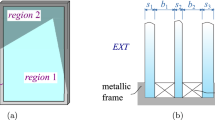Abstract
Due to the increased mechanical strength and with respect to safety, tempered and strengthened glass plates are increasingly employed in modern buildings as architectural and structural components. However, regarding the complete fragmentation by disturbing the equilibrated residual stress state in thermally toughened glass, drillings or cut-outs must be done before quenching the glass. The present paper demonstrates 3D results of the thermal tempering simulation by the Finite Element Method in order to calculate the residual stresses in the area of the holes or cut-outs of a tempered glass plate. A viscoelastic material behavior of the glass is considered for the simulation of the tempering process. The structural relaxation is taken into account using Narayanaswamy’s model. Due to different cooling rates of the convection areas such as edge, chamfer, hole’s inner surface and far-field area, heat transfer coefficients are estimated using experimental data from the literature. It is the objective of the paper to demonstrate the simulation of the residual stresses in tempered glasses with holes or cut-outs and to quantify the amount of temper stresses based on a variation of different geometrical parameters and the local heat transfer coefficient. The residual stresses are thus calculated varying the following parameters: the hole diameter, the plate thickness, different geometries of the cut-outs and heat transfer coefficient.




(Reproduced with permission from Bernard and Daudeville 2009)

























Similar content being viewed by others
References
Aben, A., Anton, J., Errapart, A.: Modern photoelasticity for residual stress measurement in glass. Strain Int. J. Exp. Mech. 44, 40–48 (2008)
ANSYS, Inc.: Ansys, 18.1 (2017)
Aronen, A.: Modelling of Deformations and Stresses in Glass Tempering. Ph.D. Thesis, Julkaisu-Tampere University of Technology. Publication, 1036 (2012)
Beason, W.L., Morgan, J.R.: Glass failure prediction model. J. Struct. Eng. 110(2), 197–212 (1984)
Bernard, F., Daudeville, L.: Point fixings in annealed and tempered glass structures: modeling and optimization of bolted connections. Eng. Struct. 31(4), 946–55 (2009)
Carre, H., Daudeville, L.: Numerical simulation of soda-lime silicate glass tempering. J. Phys. IV 6, 175–85 (1996)
Carre, H., Daudeville, L.: Load-bearing capacity of tempered structural glass. J. Eng. Mech. 125(8), 914–21 (1999)
Daudeville, L., Bernard, F., Gy, R.: Residual stresses near holes in tempered glass plates. Mater. Sci. Forum 404–407, 43–48 (2002)
EN 12150-1: Glass in building—thermally toughened soda lime silicate safety glass—part 1: definition and description (2015)
Gardon, R.: The tempering of flat glass by forced convection. In: VIIth International Congress on Glass, Brussels, Belgium, Paper No. 79, pp. 14 (1965)
Gardon, R., Narayanaswamy, O.S.: Stress and volume relaxation in annealing flat glass. J. Am. Ceram. Soc. 53(7), 380–85 (1970)
Kurkjian, C.: Relaxation of torsional stress in transformation range of soda–lime–silica glass. Phys. Chem. Glasses 4(4), 128–36 (1963)
Laufs, W.: Ein Bemessungskonzept zur Festigkeit thermisch vorgespannter Gläser. Ph.D. Thesis, RWTH Aachen (2000)
Lee, E.H., Rogers, T.G., Woo, T.C.: Residual stresses in a glass plate cooled symmetrically from both surfaces. J. Am. Ceram. Soc. 48(9), 480–87 (1965)
Narayanaswamy, O.S.: A model of structural relaxation in glass. J. Am. Ceram. Soc. 54(10), 491–98 (1971). https://doi.org/10.1111/j.1151-2916.1971.tb12186.x
Narayanaswamy, O.S.: Stress and structural relaxation in tempering glass. J. Am. Ceram. Soc. 61(3), 146–52 (1978)
Nielsen, J.H., Olesen, J.F., Poulsen, P.N., Stang, H.: Finite element implementation of a glass tempering model in three dimensions. Comput. Struct. 88(17–18), 963–72 (2010a)
Nielsen, J.H., Olesen, J.F., Poulsen, P.N., Stang, H.: Simulation of residual stresses at holes in tempered glass: a parametric study. Mater. Struct. 43(7), 947–61 (2010b)
Nielsen, J. H.: Tempered glass: bolted connections and related problems. Ph.D. Thesis, Technical University of Denmark, Dept. of Civil Eng (2009)
Pourmoghaddam, N., Nielsen, L. H. and Schneider, J.: Numerical simulation of residual stresses at holes near edges and corners in tempered glass?: A parametric study. In: Engineered Transparency International Conference at Glasstec. pp. 513–525 (2016)
Schneider, J.: Festigkeit und Bemessung punktgelagerter Gläser und stoßbeanspruchter Gläser. Ph.D. Thesis, Technische Universität Darmstadt (2001)
Schneider, J., Hilcken, J., Aronen, A., Karvinen, R., Olesen, J.F., Nielsen, J.H.: Stress relaxation in tempered glass caused by heat-soak-testing. Eng. Struct. 122, 42–49 (2016a)
Schneider, J., Kuntsche, J., Schula, S., Schneider, F., Wörner, J.D.: Glasbau Grundlagen, Berechnung, Konstruktion, 2nd edn. Springer, Berlin (2016b)
Schwarzl, F., Staverman, A.J.: Time-temperature dependence of linear viscoelastic behavior. J. Appl. Phys. 23(8), 838–43 (1952)
Tool, A.Q.: Relation between inelastic deformability and thermal expansion of glass in its annealing range. J. Am. Ceram. Soc. 29(9), 240–53 (1946)
Author information
Authors and Affiliations
Corresponding author
Appendix
Appendix
Rights and permissions
About this article
Cite this article
Pourmoghaddam, N., Schneider, J. Finite-element analysis of the residual stresses in tempered glass plates with holes or cut-outs. Glass Struct Eng 3, 17–37 (2018). https://doi.org/10.1007/s40940-018-0055-z
Received:
Accepted:
Published:
Issue Date:
DOI: https://doi.org/10.1007/s40940-018-0055-z




